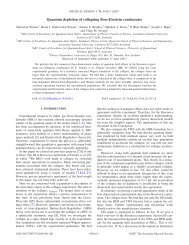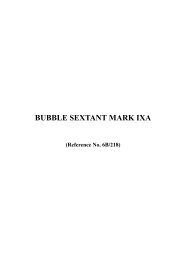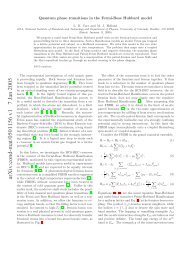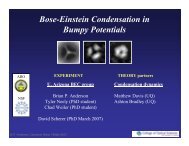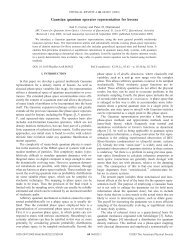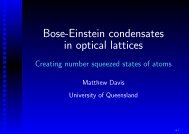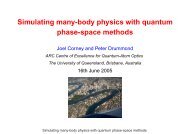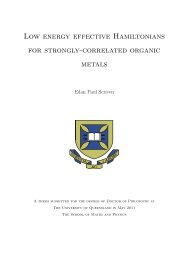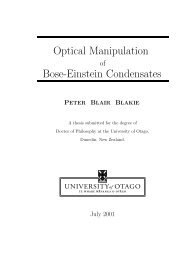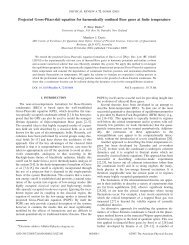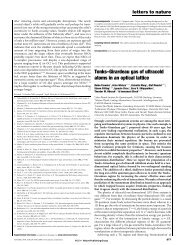Open Quantum Dynamics of Mesoscopic Bose-Einstein ... - Physics
Open Quantum Dynamics of Mesoscopic Bose-Einstein ... - Physics
Open Quantum Dynamics of Mesoscopic Bose-Einstein ... - Physics
You also want an ePaper? Increase the reach of your titles
YUMPU automatically turns print PDFs into web optimized ePapers that Google loves.
7. <strong>Quantum</strong> simulations <strong>of</strong> evaporatively cooled <strong>Bose</strong> condensates(real) time domain to allow dynamical calculations has not yet been achieved, althoughprogress to this end has been made with coherent-state operator expansions[21].Any simulation <strong>of</strong> evaporative cooling must include all the relevant modes for thetrapped atoms, up to the energy levels required for hot atoms to escape. The threedimensionalcalculations presented here include more than 3 × 10 4 relevant modes, withup to 1.0 × 10 4 atoms present. The quantum state vector therefore has over 10 40000 components.Keeping track <strong>of</strong> all these components and calculating the evolution matrix toperform quantum number-state calculations in the time domain is an enormous computationalproblem, as Feynman emphasised.But we have seen in Ch. 6 how a many-body multimode quantum system can besimulated, using the phase-space methods that have already proved successful in lasertheory[67, 111, 169]. These techniques can handle large numbers <strong>of</strong> particles, but can alsosystematically treat departures from classical behaviour. For example, generalised phasespacerepresentations were used to correctly predict quadrature squeezed quantum solitondynamics in optical fibres[24, 50], which as we saw in Ch. 6 are described by nearly identicalquantum equations (Eq. (6.3)) to those used in atom-atom interaction studies[163]. Thecoherent-state (positive-P ) phase-space equations are exactly equivalent to the relevantquantum equations, provided that phase-space boundary terms 1 vanish. They have theadvantage that they are computationally tractable for the large Hilbert spaces typical <strong>of</strong><strong>Bose</strong> condensation experiments. Techniques <strong>of</strong> this sort may provide a way <strong>of</strong> extendingQMC methods[28, 29] into the time domain.7.3 Phase-space equationsThe model that we will use includes the usual nonrelativistic Hamiltonian for neutralatoms, in a trap V (x), interacting via a potential U(x), in d =2ord = 3 dimensions:∫Ĥ =[ d d 2x2m ∇ ˆψ † (x)∇ ˆψ(x)+V (x) ˆψ † (x) ˆψ(x)+ ˆψ † (x) ˆR(x)+ ˆψ(x) ˆR † (x)+ 1 2∫d d yU(x − y) ˆψ † (x) ˆψ † (y) ˆψ(y) ˆψ(x)]. (7.1)Where ˆψ † and ˆψ are the bosonic many-body creation and annihilation operators for atomsat position x. HereˆR(x) represents a localised absorber that removes the neutral atoms;1 A careful treatment <strong>of</strong> this problem <strong>of</strong> boundary terms appears in [60]. See also [163].145



